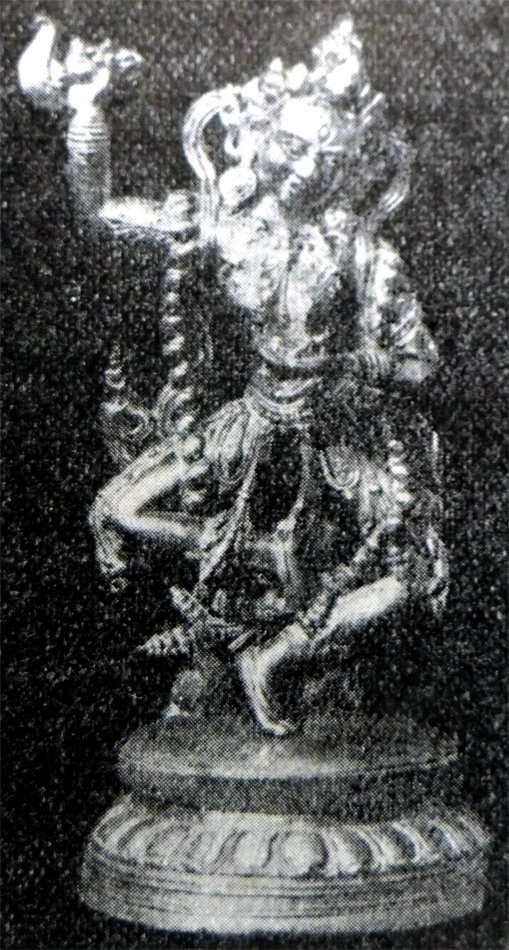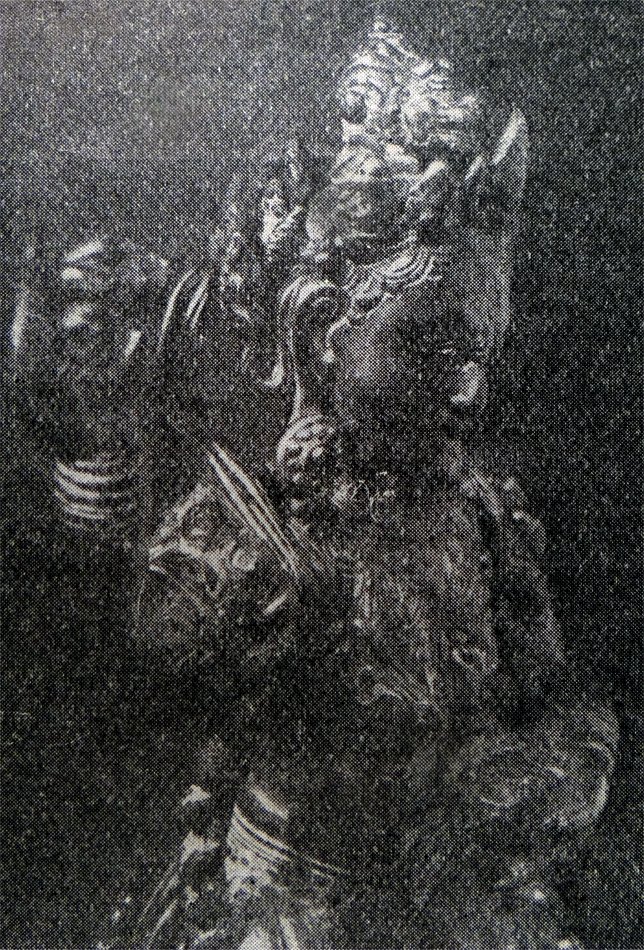The Indian Buddhist Iconography
by Benoytosh Bhattachacharyya | 1958 | 51,392 words | ISBN-10: 8173053138 | ISBN-13: 9788173053139
This page contains an iconography image of Four Animal-Faced Goddesses: Simhasya and represents figure 215-216 of the book Indian Buddhist Iconography, based on extracts of the Sadhanamala English translation. These plates and illustrations represent either photographs of sculptures or line-drawing reproductions of paintings or other representations of Buddhist artwork.
Figure 215-216 - Four Animal-Faced Goddesses: Siṃhāsyā
 Fig. 215: Siṃhāsyā (Dr. Moghe’s Collection) |
 Fig. 216: Siṃhāsyā (Upper View showing the lion-head) |
There is a set of four very interesting deities described in the Niṣpannayogāvalī; they all have animal faces and have several forms. They are given each a different direction in the Maṇḍala. Their names are: Hayāsyā, Śūkarāsyā, Śvānāsyā, and Siṃhāsyā, according to the animal face they bear. To this number, in the Kālacakra-maṇḍala, four more deities with birds faces are added for the intermediate corners. These birds deities are named as Kākāsyā (crow-faced), Gṛdhrāsyā (vulture-faced), Garuḍāsyā (Garuḍa-faced) and Ulūkāsyā (owl-faced). All these are described in the text as violent in appearance, nude, dancing on a corpse, and wearing garlands of severed heads. They carry in their hands the Kartri (chopper) and the Kapāla (skull-cup). A Khaṭvāṅga (magic stick) hangs from their shoulders.
They [viz., Siṃhāsyā] are sometimes two-armed and at others four-armed. When four armed, the four chief deities are represented like the goddesses of the Vajrāṅkuśī group. With regard to the face, it may be noted that the principal face is either human or of an animal. When it is human, the animal face is shown over the head or on the crown. Normally, there are four goddesses in this group, but the series of goddesses found only in the Kālacakra-maṇḍala are without adequate description. The group of four goddesses of the Nairātmā-maṇḍala is here described. It may be noted that their images are also popular in the Chinese collection of Peiping, although a few are available in India also.
4. Siṃhāsyā:
Colour: reddish blue;
Arms: two;
Symbol: lion-face.
The fourth and the last deity in the series is called Siṃhāsyā (lion-faced) in the Nairātmā-maṇḍala. Her form is described thus: “On the North there is Siṃhāsyā of reddish blue colour”. Like all other deities of the group she also holds the Kartri in the right hand and the Kapāla in the left.
She is described in the Hevajra-maṇḍala as four-faced and four-armed, and as similar in appearance to Vajraghaṇṭā.
Under the title of Siṃhavaktrā she appears in the Chinese collection at Peiping. She was also known in Tibet. Figs, 215, 216 illustrate a very artistic specimen of Siṃhāsyā with human face with the face of the lion overhead. This image is in the collection of Dr. Moghe of Khar (Bombay).
